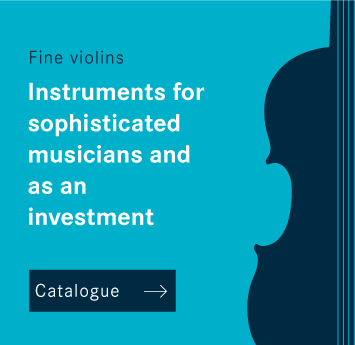W. E. Hill & Sons: A London violin legend.
On the history of the renowned Stradivari experts and their workshop
W.E. Hill & Sons was one of the most renowned companies in the history of violin making. It not only worked extensively in crafting and trading fine stringed instruments, bows and accessories, it also established a legendary reputation with its expertise in historic stringed instruments.
W. E. Hill & Sons, content overview:
- W. E. Hill’s roots in classic violin making
- W. E. Hill & Sons – at the pinnacle of the luthier’s art
- A legend within the legend: The bow-making workshop at W. E. Hill & Sons
W. E. Hill’s roots in classic violin making
William Ebsworth Hill (1817-1895), son of an old and highly esteemed family of London violin makers, began pursuing the family trade at the age of 14 by working at the atelier operated by his father, Henry Lockey Hill (1774-1835), and brother. After his brother's death in 1837, he had a brief intermezzo as a violin maker employed in someone else's workshop before opening his own atelier the following year. This business allowed him to establish a solid name for himself as an outstanding repairer, but he also demonstrated universal knowledge in creating both stringed instruments and bows of exceptional quality (albeit in modest numbers).
W. E. Hill & Sons – at the pinnacle of the luthier’s art
From 1887 onward, after his four sons had joined the company, Wiliam Ebsworth Hill was in a position to dedicate himself to his passion for the historic masterpieces of Cremonese violin making, quickly becoming the leading Stradivari expert of his day. W. E. Hill created a highly successful business in trading valuable historic stringed instruments. In his work he drew upon his extensive experience as a violin maker; he was also incorruptible in his professional assessment and respected as an entrepreneur.  W.E. Hill & Sons on London's New Bond Street advanced to become what William Henley called the “Mount Parnassus of the art of violin making,” an international venue where musicians, artists and collectors gathered. Around the turn of the century, the workshop had reached an early zenith, had been awarded numerous medals and appointed among the violin and bow makers of many European rulers including the kings of England, Italy and Portugal.
W.E. Hill & Sons on London's New Bond Street advanced to become what William Henley called the “Mount Parnassus of the art of violin making,” an international venue where musicians, artists and collectors gathered. Around the turn of the century, the workshop had reached an early zenith, had been awarded numerous medals and appointed among the violin and bow makers of many European rulers including the kings of England, Italy and Portugal.
A legend within the legend: The bow-making workshop at W. E. Hill & Sons
The success and enduring reputation of W.E. Hill & Sons was due in no small part not only to the atelier's trade in old Cremonese masterpieces; it also offered premium-quality violin bows and cello bows which had been produced by a long series of specialists who worked for the Hills. Some of these master craftsmen included the young James Tubbs (1835-1921) and William Charles Retfort (1875-1970), outstanding artists who set standards in the bow making of the 19th and 20th centuries. As masterpieces, bows by W.E. Hill & Sons were usually marked with symbols which indicate their maker; bows made by William C. Retfort, for example, have a dot on the head plate. Apparently, however, this was not the W.E. Hill & Sons' custom from the outset, which is why many early James Tubbs bows feature not only the W.E. Hill & Sons mark but the name of its maker added at a later date. In 1992, the long history of W. E. Hill & Sons came to an end; its heirs include several independent smaller instrument brokerages which are run by members of the family. To this day, the Hills' appraisals and publications remain a valid source and valuable reference for research on musical instruments, especially those on Antonio Stradivari.
Related articles:
Nicolas Lupot - the "French Stradivarius"
John & Arthur Beare, Beares, London: expertise in changing times
Rembert Wurlitzer and the travels of antique violins
Vatelot-Rampal: on the art of healing violins
Eric Blot, expert of Cremona
Jean-François Raffin: ten hours - and not a word
Le Canu-Millant, Paris: lutherie and expertise
Contemporary violin makers - the modern artisans
International violin making competitions -- an overview
Samuel Zygmuntowicz: understanding Stradivarius







